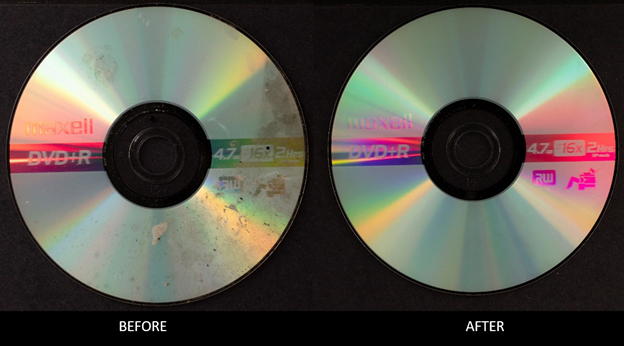In my last post, I discussed my cleaning tests for removing soot and water spots from fire damaged CDs and DVDs. In this post, I explain my general conclusions from this work.
Comparing the before and after treatment photography and making general observations of the discs helped me ascertain that the cleaning methods I used were successful in removing most of the soot and water spot damage. So, it is safe to confirm that Kimwipes, distilled water, and isopropanol continue to be some of the most effective tools for treating soot and water exposure on optical discs, as was mentioned in several of the older publications that I had researched. The next step was to determine whether I could actually read information from all the cleaned discs when inserted into a spare, offline computer.
Another data point for the study was gleaned by comparing the data on the discs. I uploaded the same eight files to each disc, which ranged from Word documents to video files. I also obtained checksums (MD5) of these files before and after the burn and cleaning process. A checksum is an alphanumeric sequence that represents a block of data which is created with an algorithm. Even the tiniest change in data, usually as a result of damage to the disc, will change the checksum. All checksums in this experiment were the same before and after the burn and cleaning tests, which suggests that these burn conditions did not cause any discernable damage to the data on the discs.

There was only one disc that was not read by the disc drive and I suspect this was because it became slightly warped during the fire event. Thermocouples (record temperature) were placed throughout the room where the test-fire occurred. A thermocouple on the shelf where my test discs were reached just above 120 C. The heat deflection temperature of polycarbonate, or the point at which the plastic of a DVD or CD starts to warp, is around 128 – 140 C which explains the single warped disc. Potential next steps could include placing the disc in different disc drives on different computers and maybe even putting it into a calibrated lab oven to flatten it (explained in a technical bulletin from 2002 by Joe Irachi from the Canadian Conservation Institute).
I was not able to find any literature that suggested two applications of solvent, one with distilled water followed by another with 70% isopropyl alcohol, which was the workflow that I used. Instead, the literature suggested using either one solvent or the other. Over-cleaning a disc could damage it, but under-cleaning it could damage the disc drive. So, even though my workflow was successful in removing soot and water damage, there is the potential of over-cleaning and causing damage to other components of the disc like the layers of dyes and metals. Thus, one must carefully toe this line between too much and too little cleaning while treating optical discs.
Ultimately, it is important to keep in mind that optical discs like CDs and DVDs tend to be quite durable. One recommendation for fire-damage treatment is to submerge discs in distilled or soapy water, though this is a last resort method to be used when there is extensive damage (also explained in . Given this durability, my treatment workflow would probably be better suited to scenarios involving a small number of discs, in which the labels on the discs are important to preserve, and where the discs are too fragile to be submerged in water.
If I had the chance to continue this work, I would spend more time thinking about cleaning and removing the pressure-sensitive adhesive labels. I would try other cleaning tools like erasers and consider factors like left-over residue of the cleaning tool, how well the cleaning tool molds to the surface of the paper, how well the cleaning tool adheres to soot, and how the cleaning tool affects the structure of the paper fibers. Also, I would research remediation strategies for other types of damage, ones that we might encounter during the accession process at the Smithsonian Institution Archives. This damage includes partially delaminated or bubbling labels, deep scratches, and obstructive ink marks.

This project was great learning exercise in developing an experiment and a fantastic way for me to get hands-on experience with the physical and digital aspects of treating items like CDs and DVDs.
Related Resources
- "Burn This Disc: Treating Fire-Affected Optical Discs, Part I" by Miguel Resendiz, The Bigger Picture, Smithsonian Institution Archives
- "Burn This Disc: Treating Fire-Affected Optical Discs, Part II" by Miguel Resendiz, The Bigger Picture, Smithsonian Institution Archives
- "Disaster Recovery of Modern Information Carriers: Compact Discs, Magnetic Tapes, and Magnetic Disks" (2002) by Joe Irachi, Technical Bulletin 25, Canadian Conservation Institute
- "Return of…the Beast" by Nora Lockshin, The Bigger Picture, Smithsonian Institution Archives
- "Longevity of Recordable CDs, DVDs and Blu-rays — Canadian Conservation Institute (CCI) Notes 19/1" by Joe Irachi, Canadian Conservation Institute
- "Glaring Discs: Photographic Condition Documentation of Reflective Surfaces" by Miguel Resendiz, The Bigger Picture, Smithsonian Institution Archives
- "Fixity and Checksums," Digital Preservation Handbook, Digital Preservation Coalition
Produced by the Smithsonian Institution Archives. For copyright questions, please see the Terms of Use.

Leave a Comment